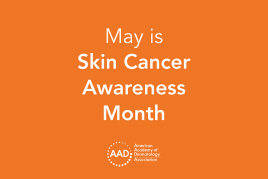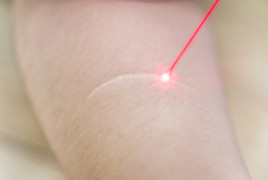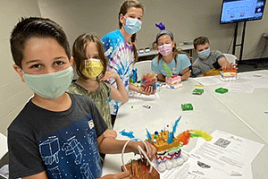Scabies: Diagnosis and treatment
How do dermatologists diagnose scabies?
A dermatologist can often diagnose scabies by visually examining a patient’s skin from head to toe.
To make sure that a patient has scabies, a dermatologist may remove some skin. This is painless. Your dermatologist will put the skin on a glass slide and look at the slide under a microscope. If your dermatologist sees scabies mites or their eggs, it is certain that you have scabies.
How do dermatologists treat scabies?
To get rid of scabies, treatment is essential. Medicine that treats scabies is only available with a doctor’s prescription.
Who needs treatment?
The person diagnosed with scabies and everyone who has had close contact with that person need treatment. Even people who do not have any signs or symptoms must be treated. This is the only way to prevent new outbreaks of scabies weeks later. People who should be treated include:
Everyone who lives with the person
Recent sexual partners
Most people can be cured with a medicine that they apply to their skin. These medicines are often applied to all skin from the neck down. Infants and young children often need treatment for their scalp and face, too. A dermatologist will provide specific instructions to follow.
Most medicine is applied at bedtime. The medicine is then washed off when the patient wakes up. You may need to repeat this process one week later.
It is important to follow your dermatologist’s instructions. Treating the skin more often than instructed can worsen the rash and itching.
Medicines that may be prescribed include:
5% permethrin cream: This is the most common treatment for scabies. It is used to treat patients 2 months of age and older and women who are pregnant.
10% crotamiton cream
25% benzyl benzoate lotion
Sulfur (5%-10%) ointment
1% lindane lotion
Treatment for widespread scabies
Scabies that covers much of the body and crusted scabies often require stronger medicine. A patient with this type of scabies may receive a prescription for ivermectin. This medicine can be prescribed to children and patients who are HIV-positive. Some patients need only to take one dose, but many need to take two or three doses to cure scabies. The pills are usually taken once every two weeks.
When scabies infects many people at a nursing home, extended-care facility, and other institution, ivermectin may be prescribed to everyone who has a risk of catching scabies.
Other signs and symptoms
Some patients need other treatment, too. Your dermatologist may prescribe:
Antihistamine: To control the itch and help you sleep.
Pramoxine lotion: To control the itch.
Antibiotic: To wipe out an infection.
Steroid cream: To ease the redness, swelling, and itch.
Outcome
Treatment can get rid of the mites, eliminate symptoms such as itch, and treat an infection that has developed. For the first few days to a week, the rash and itch can worsen during treatment. Within four weeks, your skin should heal.
If your skin has not healed within 4 weeks, you may still have mites. Some people need to treat two or three times to get rid of the mites. Be sure to see your dermatologist for treatment. You should never use a scabicide used to treat crops or livestock.
People who develop crusted scabies, also known as Norwegian scabies, often need repeat treatments to get rid of the mites.
To get rid of the mites and prevent getting scabies again, you have to do more than treat the skin or take a pill. You will need to wash clothes, bedding, and towels to get rid of mites that may have fallen off your skin. You also should vacuum your entire home.
References
Chosidow O. Clinical practices. "Scabies." N Engl J Med 2006; 354: 1718-27.
Czelusta A, Yen-Moore A, Van der Straten M et al. "An overview of sexually transmitted diseases. Part III. Sexually transmitted diseases in HIV-infected patients." J Am Acad Dermatol 2000; 43: 409-32; quiz 33-6.
Elston DM. "Controversies concerning the treatment of lice and scabies." J Am Acad Dermatol 2002; 46: 794-6.
Habif, Campbell, Chapman, et al. In: Dermatology DDxDeck. 2006. China. Mosby Elsevier. Card #92: "Scabies."
Jacobson CC, Abel EA. "Parasitic infestations." J Am Acad Dermatol 2007; 56: 1026-43.
Steen CJ, Carbonaro PA, Schwartz RA. "Arthropods in dermatology." J Am Acad Dermatol 2004; 50: 819-42, quiz 42-4.
 Think sun protection during Skin Cancer Awareness Month
Think sun protection during Skin Cancer Awareness Month
 How to care for your skin if you have lupus
How to care for your skin if you have lupus
 Practice Safe Sun
Practice Safe Sun
 Sunscreen FAQs
Sunscreen FAQs
 Fade dark spots
Fade dark spots
 Hidradenitis suppurativa
Hidradenitis suppurativa
 Laser hair removal
Laser hair removal
 Scar treatment
Scar treatment
 Botox
Botox
 Kids' camp - Camp Discovery
Kids' camp - Camp Discovery
 Dermatologist-approved lesson plans, activities you can use
Dermatologist-approved lesson plans, activities you can use
 Find a Dermatologist
Find a Dermatologist
 Why choose a board-certified dermatologist?
Why choose a board-certified dermatologist?